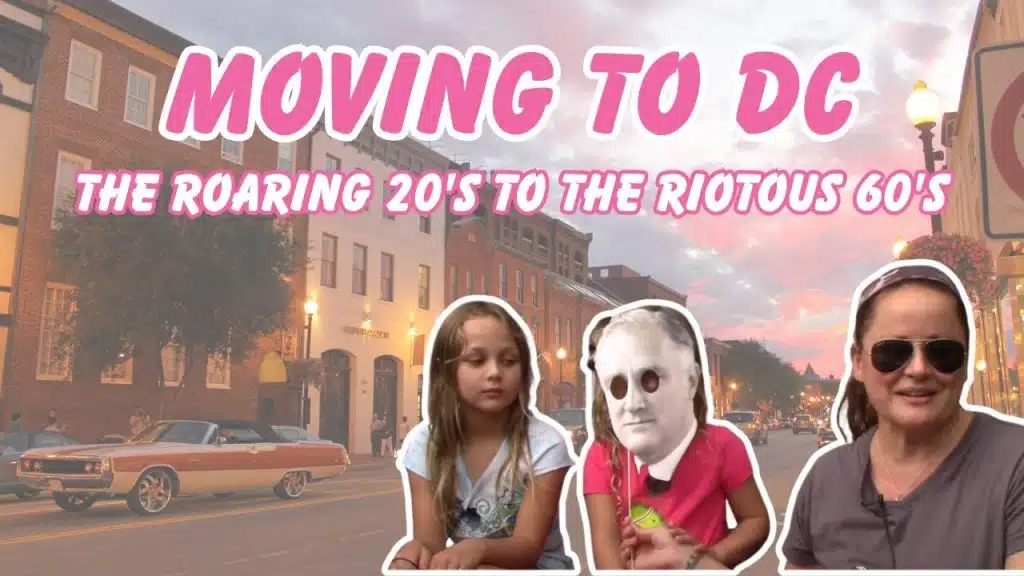The History of Washington DC
We’re back with part 3 of your DC history lesson with the DC Real Estate Mama—along with my two helpers, one of whom may or may not be Harry Truman. This time we’re starting in the 1920s and it’s gonna be a bumpy ride! (If you haven’t seen parts 1 or 2, make sure you check them out to get caught up to speed).
The KKK was allowed to march on Washington in the 1920s. Despite this fact, black culture was gaining a footing in a DC neighborhood called Uptown. U Street, the commercial area, was home to hundreds of black-owned businesses.
Uptown housed a variety of important projects, such as the True Reformer Building. Opened in 1903, it was one of the first buildings to be built—from conception to completion—solely by black men. Duke Ellington grew up in this neighborhood, playing his first gig at the True Reformer Hall and returning often in later years to play again.
Another notable building is U Street’s Lincoln Theatre, which opened in 1910. Many notable R&B and Blues singers performed here, and an underground ballroom opened in 1923 behind the theatre —under the parking lot. Another theatre, the Dunbar, opened up in 1920.
Community donations helped open the YMCA on 12th Street between S and T Streets, with a $25,000 grant given by J.D. Rockefeller. President Roosevelt called the building a monument to the advancement of the city of Washington. The Y is now on W Street, named after Anthony Bowen. This ex-slave started the first YMCA for “colored” men and boys.
On 13th and U Street, the Whitelaw Hotel was named after John Whitelaw Lewis. He started the first bank for black people call Industrial Bank, which still lies at 11th and U Street.
Moving on to the late 1920s and early 30s, Herbert Hoover’s one-term presidency brought both positives and negatives to the country. While known for his business sense and humanitarian ways, one incident regarding a bonus promised to WWI veterans turned into turmoil.
Congress had promised a bonus to WWI servicemen, but it was not to be paid until 1945. Sadly, many of the men who fought in this war might not be alive to collect on the promise. With the Great Depression wreaking havoc on the U.S economy and unemployment at an all-time high, the WWI veterans decided they would collect on their bonus early. Dubbed the “Bonus Army, they set out for Washington.
Hoover decided that it was a local problem, not a federal one, and sent the DC police out to deal with it. After two of the Bonus Army was shot, U.S army troops were summoned and went into attack mode. Tanks, tear gas, and machine guns were brought out, and the U.S Army’s General MacArthur ignored Hoover’s instructions to stop the attack. MacArthur burned the biggest Bonus Army camp to the ground, changing the whole idea of peaceful public assembly.
After Hoover, Franklin Delano Roosevelt’s ability to connect with the people resulted in a 3-term presidency—the only one the U.S. has ever seen. FDR’s New Deal helped people get back to work, creating jobs and permanent agencies that grew employment 160% in DC. These new jobs created a massive construction boom, with the Supreme Court, Federal Reserve Building, Jefferson Memorial, and the Pentagon all built during this era.
DC was fairly free until the Pearl Harbor attack of 1941. Thereafter, snipers and guards protected The White House. The Declaration of Independence and the Constitution were also relocated to Fort Knox. During this time, DC became packed with people arriving in the city as WWII raged on. This created a massive housing shortage, with people living in boarding houses and renting rooms from homeowners. Some of the boarding houses were stylish and housed more than 600 people in a collection of 23 brownstones.
To address housing concerns, the government begins to build its own housing to become the city’s biggest landlord. Many tenants are called “Government Girls,” which local newspapers branded as a “girls gone wild” type situation. An entire article from the Washington Post blamed the government for not properly “supervising” the girls and turning them loose in a city full of men.
In 1942, construction began on McLean Gardens, owned by the son of a wealthy businessman named John McLean. The hotel was part of a larger 3,100-acre tract of land originally granted to Colonel Thomas Addison and James Stoddert in 1718. James Stoddert’s grandson, Benjamin, is the namesake of a local Glover Park elementary school.
These men named the land “Friendship” in honor of their bond, which is how Friendship Heights got its name. The mansion built by the McLeans was designed by John Russell Pope, the same architect behind the Jefferson Memorial and the National Gallery of Art. The McLean’s were socialites, partying with important people and spending lots of money. John’s wife Evelyn was the last private owner of the Hope Diamond, now housed at the Smithsonian. They eventually sold the estate for $1,000,000 cash and 45 buildings took the original mansion’s place. These buildings housed 720 families as government housing until 1948, then was converted to condominiums in 1981.
In the 1940s, armed services were segregated. Black people weren’t allowed to be in the Navy unless serving as mess hall attendants or cooks. They were not allowed in the Marines at all. FDR’s wife, Eleanor Roosevelt, nudged her husband to meet with the head of the NAACP. The president then signed a governmental non-discrimination policy against race, color, creed, or national origin. He also creates the Fair Housing Employment And Practices Committee.
When WWII was finally over, things slowly went back to normal. The U.S. was considered the largest superpower in the world, and the country grew as well as D.C. However, between 1950-2000, the population of the city decreased by almost 30%. With threats of an atomic bomb from Russia, government officials moved out of the city and created the prototype for the modern suburb.
A Highway plan originally hoped to included 3 beltways to bring traffic out to the suburbs; instead, DC got the outermost beltway, which is now known as 495. By the mid-1950s, all other highway plans fell apart, while Washington’s population steadily decreased. Voting for anything in the city was impossible.
During the 16 years of presidencies of Truman, Eisenhower, and FDR, there were periods of incredible progress for civil rights. While DC was the first place to integrate schools in 1954, “white flight” was so swift that districts were 95% black after just 10 years. DC got voting rights in 1961, voting Democrat in every single presidential election since. However, despite paying federal taxes, DC has no representation in congress.
In 1962, JFK forced the Redskins to allow black players on the team. In 1963, a march on Washington by both black and white called for equality for all. Sadly, JFK was killed that same year, and his legislation was never signed. Thankfully, the next president Lyndon B. Johnson signed a bill of civil rights that passed in 1964. The next year, LBJ tried to get home rule for DC passed, but it was sabotaged. Instead, he proposed that DC have a mayor and a council. Congress agreed—as long as they controlled the budget.
In 1967, LBJ appoints Walter Washington—a black man—mayor of Washington DC. He faces plenty of racism.
In 1968, Martin Luther King Jr. was shot almost 103 years to the day after Abraham Lincoln was. His death sets off a massive wave of riots throughout the city, affecting DC for decades to come.
Stay tuned for the final part to learn more about DC history!





